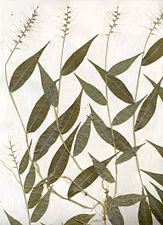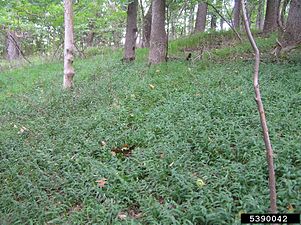I pulled some wavyleaf basketgrass this morning. "So what," you say. In fact I first noticed this weed last year but wasn't particularly concerned until I learned more about it. This is a highly invasive alien weed taking over our woodlands. It is new to our area and extremely difficult to eradicate once established.
I have been finding it scattered in my garden this summer. If you don't know it and pull it -- it will get worse each year as it's a perennial. At a recent course at the National Arboretum our instructor referred to wavyleaf basketgrass as "the weed from hell." It joins the ranks of other invaders like mile-a-minute which can grow more than a foot a day. Or stiltgrass which is now almost everywhere in our area, including natural areas. Commonly planted shrubs that are alien invasives include the Japanese barberry and the burning bush. It pays to know invasive plants so you can pull them out before they take hold in your garden/lawn. This protects nearby natural areas. Please share this information as most people are oblivious to this very serious environmental problem. Go to mdflora.org for more info on invasive plants for our area (Maryland Native Plant Society).
Wavyleaf basketgrass pulled from Merikay's garden.
Small areas of wavyleaf basketgrass can be handpulled. Roots of pulled plants should be hung to dry before disposing so as to kill the plant before putting it out in the county recycling. I would not compost it on site. Plants with seeds should be double bagged and disposed or burned. Large infestations might require herbicide applications which is why is important to share this information and get these plants pulled before they spread.
I'm posting some photos and info from Wikipedia: "Accidentally introduced into the United States in Maryland and Virginia, this species spreads quickly and is becoming extremely invasive in forested natural areas in the Mid-Atlantic region across numerous counties in Maryland and Virginia.
The species was first reported in Maryland in 1996, growing around the Liberty Reservoir area and the northern section of the Patapsco River in Howard County. The grass spread quickly into connected natural areas in Baltimore and Carroll counties. By 1999 it was identified in Montgomery County at Wheaton Regional Park.[16] It had crossed into Virginia by 2004 where it was found growing at a 80-acre site in Shenandoah National Park, and in a 20–30-acre site at the Fraser Preserve along the Potomac River in Fairfax County.[17]
Once a population has become established, complete eradication from a site has proven to be extremely difficult due to a long-lived perennial life cycle, a long seed germination season (April–November), and considerable seed mobility of the species."
The photos below show the wavyleaf seeds and an infested Maryland woodland where the native groundcover has been replaced by this invasive.


